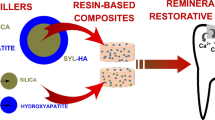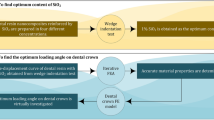Abstract
Objective
The proposed study aimed to fabricate and evaluate the physical, mechanical, thermal, thermo-mechanical, and wear analysis of tri-calcium phosphate and silica filled dental resin composite materials.
Materials and Methods
Five dental composite series (TSi0, TSi1, TSi2, TSi3, and TSi4) were developed using organic and inorganic materials. Tricalcium phosphate (TCp) and silicon dioxide (SiO2) were used as filler particles. The amount of TCp varied from 0 to 4 wt.% while SiO2 was constant as 20 wt.%. In this work, physical (void content, water sorption, water solubility, and polymerization shrinkage), mechanical (compressive strength and Vickers hardness), thermal, thermo-mechanical, and wear analysis were investigated.
Results
The maximum water sorption and solubility were found in TSi4 designated dental composite. The depth of cure decreased with filler loading, with TSi0 achieving the maximum depth of cure. TSi4 displayed a 55.3% higher compressive strength than TSi1 and 8.6% less polymerization shrinkage than TSi0. The filler loading directly influenced the hardness. Fourier-transform infrared spectra showed shifts in peak wave numbers for nano silica and tricalcium phosphate fillers. TSi4 demonstrated the highest storage modulus at 426.01 MPa. In terms of thermal stability, TSi4 outperformed TSi3, TSi2, TSi1, and TSi0 within the temperature span of 25–300 °C, as determined by thermogravimetric analysis. Moreover, specific wear was evaluated through a pin-on-disc wear test rig and using Taguchi L25 orthogonal array to design the experiment with four factors: normal load, filler loading, RPM, and time. The hybrid dental resin composite substantially affected mechanical, thermal, and viscoelastic characteristics. Grey relational analysis (GRA) approach was used to determine the ranking of dental composites. According GRA method, TSi4 designated dental composite obtained first rank among the dental composites.
Significance
In conclusion, this research offers valuable insights into optimizing dental composite formulations to enhance the performance of dental restorative materials.
Similar content being viewed by others
Data Availability
The data that supports the findings of this study are available within the article and its supplementary material. No data was used for the research described in the article.
References
Voruganti K (2008) Dental materials: properties and manipulation (9th edition). Br Dent J 204:160–160. https://doi.org/10.1038/bdj.2008.75
Arifa MK, Ephraim R, Rajamani T (2019) Recent advances in dental hard tissue remineralization: a review of literature. Int J Clin Pediatr Dent 12:139–144. https://doi.org/10.5005/jp-journals-10005-1603
Noushad M, Ab Rahman I, Husein A, Mohamad D (2016) Nanohybrid dental composite using silica from biomass waste. Powder Technol 299:19–25. https://doi.org/10.1016/j.powtec.2016.05.035
Hsissou R, Seghiri R, Benzekri Z et al (2021) Polymer composite materials: a comprehensive review. Compos Struct 262:113640. https://doi.org/10.1016/j.compstruct.2021.113640
Tian M, Gao Y, Liu Y et al (2008) Fabrication and evaluation of Bis-GMA/TEGDMA dental resins/composites containing nano fibrillar silicate. Dent Mater 24:235–243. https://doi.org/10.1016/j.dental.2007.05.002
da Silva AO, Fiorin L, Faria ACL et al (2022) Translucency and mechanical behavior of partially stabilized monolithic zirconia after staining, finishing procedures and artificial aging. Sci Rep 12:16094. https://doi.org/10.1038/s41598-022-20120-y
Najafi H, Akbari B, Najafi F et al (2018) Characterization of the physical–mechanical properties of dental resin composites reinforced with novel micro-nano hybrid silica particles: an optimization study. J Macromol Sci Part A Pure Appl Chem 55:736–746. https://doi.org/10.1080/10601325.2018.1526040
Gbadebo O, Ajayi D, Dosumu Oyekunle O, Shaba P (2014) Randomized clinical study comparing metallic and glass fiber post in restoration of endodontically treated teeth. Indian J Dent Res 25:58. https://doi.org/10.4103/0970-9290.131126
Fielding GA, Bandyopadhyay A, Bose S (2012) Effects of silica and zinc oxide doping on mechanical and biological properties of 3D printed tricalcium phosphate tissue engineering scaffolds. Dent Mater 28:113–122. https://doi.org/10.1016/j.dental.2011.09.010
Samuel SP, Li S, Mukherjee I et al (2009) Mechanical properties of experimental dental composites containing a combination of mesoporous and nonporous spherical silica as fillers. Dent Mater 25:296–301. https://doi.org/10.1016/j.dental.2008.07.012
Wang H, Zhu M, Li Y et al (2011) Mechanical properties of dental resin composites by co-filling diatomite and nanosized silica particles. Mater Sci Eng, C 31:600–605. https://doi.org/10.1016/j.msec.2010.11.023
Zandinejad AA, Atai M, Pahlevan A (2006) The effect of ceramic and porous fillers on the mechanical properties of experimental dental composites. Dent Mater 22:382–387. https://doi.org/10.1016/j.dental.2005.04.027
Yadav R, Meena A (2022) Mechanical and two-body wear characterization of micro-nano ceramic particulate reinforced dental restorative composite materials. Polym Compos 43:467–482. https://doi.org/10.1002/pc.26391
Yang F, Zhao H, Wang W et al (2021) Atomic origins of the strong metal-support interaction in silica supported catalysts. Chem Sci 12:12651–12660. https://doi.org/10.1039/d1sc03480d
Kourtis SG (1997) Bond strengths of resin-to-metal bonding systems. J Prosthet Dent 78:136–145. https://doi.org/10.1016/S0022-3913(97)70117-3
Surya Raghavendra S, Jadhav GR, Gathani KM, Kotadia P (2017) Bioceramics in endodontics – a review. J Istanb Univ Fac Dent 51:S128–S137. https://doi.org/10.17096/jiufd.63659
Yadav R, Kumar M (2019) Dental restorative composite materials: a review. J Oral Biosci 61(2):78–83. https://doi.org/10.1016/j.job.2019.04.001
Yadav R (2022) Fabrication, characterization, and optimization selection of ceramic particulate reinforced dental restorative composite materials. Polym Polym Compos 30. https://doi.org/10.1177/09673911211062755
Saini S, Meena A (2020) Enhancement of thermal conductivity of liquid by dispersing ultrafine particles of fly ash. Int J Technical Res Sci Special:7–15. https://doi.org/10.30780/specialissue-icrdet-2019/002
Yadav R (2021) Analytic hierarchy process-technique for order preference by similarity to ideal solution: a multi criteria decision-making technique to select the best dental restorative composite materials. Polym Compos 42(12):6867–6877. https://doi.org/10.1002/pc.26346
Müller JA, Rohr N, Fischer J (2017) Evaluation of ISO 4049: water sorption and water solubility of resin cements. Eur J Oral Sci 125:141–150. https://doi.org/10.1111/eos.12339
Meena A, Mali HS, Patnaik A, Kumar SR (2018) Effect of adding nanoalumina and marble dust powder on the physical, mechanical, and thermo-mechanical characterization of dental composite. Polym Compos 39:E321–E331. https://doi.org/10.1002/pc.24131
Yadav R, Lee HH (2022) Ranking and selection of dental restorative composite materials using FAHP-FTOPSIS technique: an application of multi criteria decision making technique. J Mech Behav Biomed Mater 132:105298. https://doi.org/10.1016/j.jmbbm.2022.105298
Geier N, Pereszlai C (2019) Analysis of characteristics of surface roughness of machined CFRP composites. Period Polytech Mech Eng 64:67–80. https://doi.org/10.3311/PPme.14436
Moore BK, Platt JA, Borges G et al (2008) Depth of cure of dental resin composites: ISO 4049 depth and microhardness of types of materials and shades. Oper Dent 33:408–412. https://doi.org/10.2341/07-104
de Camargo EJ, Moreschi E, Baseggio W et al (2009) Composite depth of cure using four polymerization techniques. J Appl Oral Sci 17:446–450. https://doi.org/10.1590/s1678-77572009000500018
Yadav R, Meena A, Patnaik A (2022) Tribological behavior of zinc oxide-hydroxyapatite particulates filled dental restorative composite materials. Polym Compos 43(5):3029–3040. https://doi.org/10.1002/pc.26597
Meena A, Bisht D, Yadav R et al (2022) Fabrication and characterization of micro alumina zirconia particulate filled dental restorative composite materials. Polym Compos 43:1526–35. https://doi.org/10.1002/pc.26473
Eliades T, Zinelis S, Kim D-G, Brantley W (2017) Structure/property relationships in orthodontic polymers. In: Orthodontic Applications of Biomaterials. Elsevier, pp 39–59. https://doi.org/10.1016/B978-0-08-100383-1.00002-3
Yadav R, Meena A (2022) Comparative study of thermo-mechanical and thermogravimetric characterization of hybrid dental restorative composite materials. Proc Inst Mech Eng L: J Mater: Des Appl 236:1122–1129. https://doi.org/10.1177/14644207211069763
Suryawanshi A, Behera N (2023) Prediction of wear of dental composite materials using machine learning algorithms. Comput Methods Biomech Biomed Engin:1–11. https://doi.org/10.1080/10255842.2023.2187671
Yadav R, Meena A (2022) Comparative investigation of tribological behavior of hybrid dental restorative composite materials. Ceram Int 48:6698–6706. https://doi.org/10.1016/j.ceramint.2021.11.220
Saini S, Meena A, Yadav R, Patnaik A (2023) Investigation of physical, mechanical, thermal, and tribological characterization of tricalcium phosphate and zirconia particulate reinforced dental resin composite materials. Tribol Int 181:108322. https://doi.org/10.1016/j.triboint.2023.108322
Finlay N, Hahnel S, Dowling AH, Fleming GJP (2013) The in vitro wear behavior of experimental resin-based composites derived from a commercial formulation. Dent Mater 29:365–374. https://doi.org/10.1016/j.dental.2012.12.005
Manivelmuralidaran V, Senthilkumar K (2020) Multi objective optimization of cold crack susceptibility of high strength low alloy steel 950A using grey relational analysis. Mater Today Proc 27:2703–2707. https://doi.org/10.1016/j.matpr.2019.11.326
Yadav R, Meena A, Patnaik A (2022) Biomaterials for dental restorative composite applications: a comprehensive review of physical, chemical, mechanical, thermal, tribological, and biological properties. Polym Adv Technol 33(6):1762–1781. https://doi.org/10.1002/pat.5648
Yadav R, Meena A (2022) Effect of aluminium oxide, titanium oxide, hydroxyapatite filled dental restorative composite materials on physico-mechanical properties. Ceram Int 48:20306–20314. https://doi.org/10.1016/j.ceramint.2022.03.311
Yadav R, Lee HH (2022) Fabrication, characterization, and selection using FAHP-TOPSIS technique of zirconia, titanium oxide, and marble dust powder filled dental restorative composite materials. Polym Adv Technol 33(10):3286–3295. https://doi.org/10.1002/pat.5780
Ryba TM, Dunn WJ, Murchison DF (2002) Surface roughness of various packable composites. Oper Dent 27:243–247
Koran P, Kürschner R (1998) Effect of sequential versus continuous irradiation of a light-cured resin composite on shrinkage, viscosity, adhesion, and degree of polymerization. Am J Dent 11:17–22
Filipov IA, Vladimirov SB (2006) Residual monomer in a composite resin after light-curing with different sources, light intensities and spectra of radiation. Braz Dent J 17:34–38. https://doi.org/10.1590/S0103-64402006000100008
Yadav R, Lee H, Lee J et al (2022) A comprehensive review: physical, mechanical, and tribological characterization of dental resin composite materials. Tribol Int 179:108102. https://doi.org/10.1016/j.triboint.2022.108102
Neves AD, Discacciati JAC, Oréfice RL, Jansen WC (2002) Correlação entre grau de conversão, microdureza e conteúdo inorgânico em compósitos. Pesqui Odontol Bras 16:349–354. https://doi.org/10.1590/S1517-74912002000400012
El-Nawawy M, Koraitim L, Abouelatta O, Hegazi H (2013) Depth of cure and microhardness of nanofilled, packable and hybrid dental composite resins. Am J Biomed Eng 2:241–250. https://doi.org/10.5923/j.ajbe.20120206.03
Tripp CP, Hair ML (1991) Reaction of chloromethylsilanes with silica: a low-frequency infrared study. Langmuir 7:923–927. https://doi.org/10.1021/la00053a019
Ghavami-Lahiji M, Firouzmanesh M, Bagheri H et al (2018) The effect of thermocycling on the degree of conversion and mechanical properties of a microhybrid dental resin composite. Restor Dent Endod 43:e26. https://doi.org/10.5395/rde.2018.43.e26
Meena A, Mali HS, Patnaik A, Kumar SR (2019) Investigation of wear behavior of nanoalumina and marble dust-reinforced dental composites. Sci Eng Compos Mater 26:84–96. https://doi.org/10.1515/secm-2017-0152
Pratap B, Nag M, Yadav R et al (2023) Dynamic mechanical analysis of zinc oxide and hydroxyapatite particulate filled dental restorative composite materials. In: AIP Conference Proceedings (Vol. 2782, No. 1). https://doi.org/10.1063/5.0154476
Rodríguez HA, Casanova H (2018) Effects of silica nanoparticles and silica-zirconia nanoclusters on tribological properties of dental resin composites. J Nanotechnol 2018:7589051. https://doi.org/10.1155/2018/7589051
Yadav R, Kumar M (2020) Investigation of the physical, mechanical and thermal properties of nano and microsized particulate-filled dental composite material. J Compos Mater 54:2623–2633. https://doi.org/10.1177/0021998320902212
Yadav R, Lee H, Meena A et al (2022) Effect of alumina particulate and E-glass fiber reinforced epoxy composite on erosion wear behavior using Taguchi orthogonal array. Tribol Int 175:107860. https://doi.org/10.1016/j.triboint.2022.107860
Fonseca ASQS, Labruna Moreira AD, de Albuquerque PPAC et al (2017) Effect of monomer type on the C-C degree of conversion, water sorption and solubility, and color stability of model dental composites. Dent Mater 33:394–401. https://doi.org/10.1016/j.dental.2017.01.010
Marghalani HY (2010) Effect of finishing/polishing systems on the surface roughness of novel posterior composites. J Esthet Restor Dent 22:127–138. https://doi.org/10.1111/j.1708-8240.2010.00324.x
Acknowledgements
The authors extend their heartfelt gratitude to the Centre of Excellence in Material Engineering at Anand I.C.E., Jaipur, and the Materials Research Center (MRC) at MNIT Jaipur for their invaluable support and guidance during the experimental work on dental composites.
Author information
Authors and Affiliations
Contributions
Sonu Saini: Writing—original draft. Anoj Meena: Writing – review & editing, supervision. Ramkumar Yadav: Writing – review & editing, supervision. Amar Patnaik: review & editing, supervision.
Corresponding authors
Ethics declarations
Ethics Approval
The research adheres to ethical guidelines, and all necessary approvals were obtained from relevant institutional review boards before conducting the study.
Consent to Participate
Informed consent was obtained from all human participants, ensuring their voluntary participation with a clear understanding of the research objectives and potential risks.
Consent for Publication
Consent for publication has been obtained from all identifiable individuals whose personal data are included in this manuscript.
Competing Interests
The authors declare no competing interests that could influence the interpretation of the research.
Additional information
Publisher's Note
Springer Nature remains neutral with regard to jurisdictional claims in published maps and institutional affiliations.
Rights and permissions
Springer Nature or its licensor (e.g. a society or other partner) holds exclusive rights to this article under a publishing agreement with the author(s) or other rightsholder(s); author self-archiving of the accepted manuscript version of this article is solely governed by the terms of such publishing agreement and applicable law.
About this article
Cite this article
Saini, S., Meena, A., Yadav, R. et al. Fabrication, Evaluation, and Performance Ranking of Tri-calcium Phosphate and Silica Reinforced Dental Resin Composite Materials. Silicon 15, 8045–8063 (2023). https://doi.org/10.1007/s12633-023-02646-6
Received:
Accepted:
Published:
Issue Date:
DOI: https://doi.org/10.1007/s12633-023-02646-6




